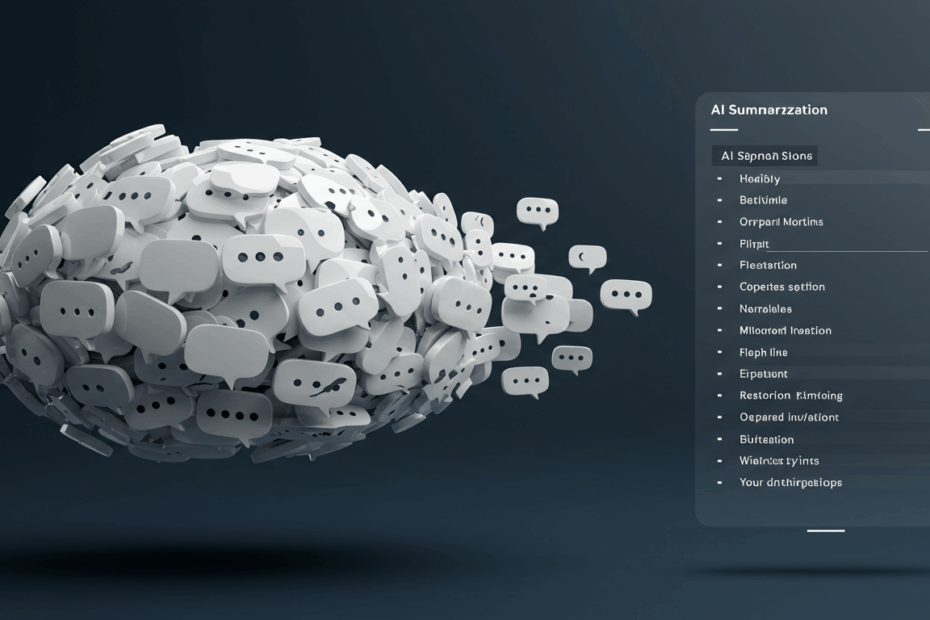Catching Up in a Flash: A Deep Dive into WhatsApp’s AI-Powered Message Summaries
John: Hello everyone, and welcome back to our AI tech corner. Today, we’re dissecting a feature that has been buzzing across the tech world, one that promises to solve a very modern problem: the endless scroll of unread messages. I’m talking about WhatsApp’s new AI-powered Message Summaries. With me is my colleague, Lila, who always brings a fresh perspective to these innovations.
Lila: Thanks, John. I’m definitely one of those people who opens a group chat to see “157 unread messages” and just closes the app in despair. So, this sounds like a dream. What exactly is this feature, and how is it supposed to save us from our digital deluge?
John: That’s the perfect way to frame it. At its core, the **WhatsApp AI Message Summaries** feature is a new, optional tool integrated directly into the app. It uses artificial intelligence—specifically, Meta’s own AI models—to automatically generate a concise, bullet-pointed summary of your unread messages within a chat. Instead of scrolling through dozens or even hundreds of messages, you get a quick recap of the key points, who said what, and what decisions were made. The goal is to let you catch up on the gist of a conversation in seconds, not minutes.
Lila: Okay, that’s a game-changer for my family’s vacation planning group chat. So, when you open a chat with a mountain of unread messages, a little summary just pops up? Is that the idea?
John: Precisely. When you enter a chat with a significant number of unread messages, you’ll see a prompt or a button, often near the unread message counter. Tapping it triggers the AI to generate the summary right then and there. It condenses the back-and-forth into the most important takeaways, so you can decide whether you need to dive into the details or if the summary is enough. It’s all about efficiency.

Who, What, When: The Supply Details
Lila: So who is the mastermind behind this? I see “Meta AI” mentioned everywhere. Is this part of Meta’s bigger push into AI across all their platforms?
John: Yes, absolutely. This feature is a direct product of **Meta AI**, the company’s artificial intelligence division. It’s a key part of their strategy to embed generative AI capabilities into their core products: Facebook, Instagram, and of course, WhatsApp. By leveraging their own powerful Large Language Models (LLMs), they can create features like this in-house. This isn’t a third-party tool bolted on; it’s a native feature built by the same company that runs the platform.
Lila: That makes sense. It feels more integrated that way. When did this officially roll out? I feel like I’ve been hearing whispers about it for a while.
John: The rollout has been phased, which is standard for a feature of this scale. It started appearing in beta versions for testing around mid-2025. The official announcements and broader public rollout began in late June 2025, with publications like The Verge, TechCrunch, and WhatsApp’s own blog marking the launch. They’ve been gradually making it available to more users globally, ensuring their systems can handle the demand and that the feature works as intended across different devices and languages.
The Magic Behind the Curtain: Technical Mechanism
Lila: Okay, John, here’s the big question that I think everyone has. To summarize my messages, the AI has to… well, *read* my messages. My WhatsApp chats are end-to-end encrypted. How does this work without compromising my privacy? I’m a bit wary of an AI combing through my private conversations.
John: That is, without a doubt, the most critical question, and Meta was clearly prepared for it. The key technology here is called **Private Processing**, or more broadly, on-device AI. Unlike many AI features that send your data to a powerful server in the cloud for processing, WhatsApp’s message summarization happens entirely on your own device—your phone.
Lila: On my phone? But isn’t my phone’s processor a lot less powerful than some giant server farm?
John: It is, and that’s the technological achievement. Meta has developed highly-efficient AI models that are small and fast enough to run directly on the hardware of a modern smartphone. Here’s a simple breakdown of the process:
- End-to-End Encryption Stays Intact: Your messages are still sent and received with end-to-end encryption. No one outside the chat, not even WhatsApp or Meta, can read them in transit or on their servers.
- On-Device Analysis: Once the messages are decrypted on your phone for you to read, the on-device AI model can then access that decrypted text locally. It’s like a tiny, hyper-specialized brain living inside your WhatsApp app.
- Local Generation: This local AI model reads the unread messages and generates the summary. The summary is created and displayed on your screen.
- Nothing Leaves Your Device: The content of your chats and the generated summary never leave your phone for the purpose of creating that summary. This is the cornerstone of their “privacy-first approach.”
This on-device method is a massive step for user privacy in the age of generative AI.
Lila: Wow, okay. “Private Processing Technology” makes a lot more sense now. So Meta isn’t training its giant AI models on my group chat’s debate about what toppings to get on the pizza?
John: Exactly. Your personal and group chat data remains yours. Meta trains its large, general-purpose AI models on vast, anonymized, and publicly available datasets, not on your private chats. The small, efficient model on your phone has already been trained; its job is simply to execute its task (summarization) using the local data you provide it in the moment.

The Team and The Community
Lila: It’s impressive that they managed to shrink the AI down to fit on a phone. What do we know about the team at Meta AI that pulled this off? And what has the public reaction been like? Is it all positive, or are people still skeptical?
John: The team is part of the broader Meta AI organization, which is one of the leading AI research groups in the world. They’ve been at the forefront of developing open-source AI models, like their Llama series. This work on creating more efficient models is what paved the way for on-device applications like this. As for the community reaction, it’s been a mix, as you’d expect.
- The Enthusiasts: Tech journalists and power users have been largely positive. They see the practical utility immediately. Sites like The Verge and 9to5Mac highlighted it as a genuinely useful, AI-powered feature that solves a real problem.
- The Privacy Advocates: While impressed by the on-device processing, this group remains cautiously optimistic. They are watching closely to ensure Meta upholds its privacy promises and that there are no hidden data-sharing mechanisms.
- The Casual Users: On platforms like Reddit, the sentiment is one of curious excitement. Many people are eager to try it, especially those in very active group chats for work, school, or hobbies. They see it as a quality-of-life improvement.
- The Skeptics: There’s also a small but vocal group, reflected in headlines like the one from Futurism (“WhatsApp Deploys AI, for Those Incapable of Reading”), that frames it as a tool for the “lazy.” They argue it could lead to less meaningful engagement with conversations.
Overall, the reception leans positive, primarily because of the clear utility and the strong emphasis on privacy from the outset.
Real-World Use Cases and The Future Outlook
Lila: I can see myself in the “enthusiast” camp. Beyond my chaotic family chat, I can think of a ton of uses. For work projects, catching up on what the team decided while I was in a meeting. For community groups, getting the summary of an event plan without reading all the “Sounds good!” messages. What are some other powerful use cases?
John: You’ve hit on the main ones. Let’s expand on that. Think about:
- Professional Coordination: A fast-moving team chat on WhatsApp. The AI summary can highlight action items, key decisions, and blockers without the project manager having to read 200 messages of chatter.
- Educational Groups: A study group chat where students discuss a complex topic. The summary can provide the main points of the explanation or list the final answers they agreed upon.
- Social Planning: Organizing a surprise party or a weekend trip. The summary could extract the final date, time, location, and who’s bringing what.
- Information Feeds: For users in WhatsApp Channels, which are one-way broadcast feeds, a summary could condense a series of updates from a news organization or content creator into a quick digest.
The potential is really in any high-volume chat where the signal-to-noise ratio can be low.
Lila: Looking ahead, where does this technology go from here? Just summarizing text seems like the first step. Could the AI start summarizing other things?
John: That’s where it gets exciting. This is almost certainly a foundational feature that Meta will build upon. The logical next steps for the AI could include:
- Voice Note Summarization: This is the holy grail for many users. Imagine getting a text summary of a 5-minute voice note. This would require more advanced speech-to-text and summarization models, but it’s a clear user need.
- Action Item Detection: The AI could get smarter, not just summarizing what was said, but actively identifying tasks. For example: “Summary: The team decided on the blue design. Action Item for Lila: Send the final mock-up by 5 PM.”
- Cross-App Integration: A summary could suggest creating a calendar event based on the plans discussed in the chat. “The party is Saturday at 8 PM.” A button could appear: “Add to Calendar.”
- Image and Video Content: In the long term, the AI might be able to describe the content of images or videos shared in a chat, e.g., “John shared 3 photos from the beach.”
The future is about making the assistant more proactive and context-aware, all while maintaining that crucial on-device privacy.

How It Stacks Up: Competitor Comparison
Lila: Is WhatsApp the first to do this? Are other messaging apps like Telegram or Signal offering AI summaries?
John: They are not the absolute first, but their approach is unique. Some competitors do have similar features, but with key differences.
- Telegram: Telegram has a chat summarization feature, but it’s typically part of its Premium subscription. It also has a feature for summarizing voice notes. However, the specifics of its privacy architecture (on-device vs. server-side) are less explicitly advertised than Meta’s.
- Third-Party Tools: For years, people have used workarounds, like exporting a WhatsApp chat to a text file and then feeding it into an AI tool like ChatGPT or Claude. This is clumsy, time-consuming, and a major privacy risk, as you’re uploading your private chats to a third-party server.
- iMessage and Others: Apple is heavily invested in on-device AI, so it’s very likely we’ll see similar summarization features in iMessage in the future. For now, however, WhatsApp’s native, free, and privacy-focused integration gives it a significant advantage in the market.
WhatsApp’s main differentiator is combining three things: it’s **native** to the app, it’s **free** for all users, and it’s built with **on-device processing** at its core. That’s a powerful combination.
Risks, Cautions, and What to Watch For
Lila: Even with the on-device processing, I can’t help but feel a little cautious. What are the potential downsides or risks we should be aware of? An AI is still an AI, right? It can make mistakes.
John: An excellent and necessary point. We should never adopt new technology without a healthy dose of critical thinking. The risks can be broken down into a few categories:
- Accuracy and Misinterpretation: The AI is not perfect. It could misunderstand sarcasm, miss a crucial piece of nuance, or incorrectly summarize a decision. Relying solely on the summary for important matters could lead to misunderstandings. It’s a guide, not gospel.
- Loss of Context and Nuance: A summary, by its nature, strips away the journey of a conversation—the jokes, the hesitations, the emotional undertones. Over-reliance could lead to a more transactional, less human interaction with our friends and family.
- The “Black Box” Problem: While we know the processing is on-device, the exact inner workings of the AI model are a “black box.” We don’t know its inherent biases or the specific rules it follows to decide what’s “important.”
- Security Model Updates: The on-device AI model will need to be updated periodically. Users must trust Meta’s process for securely delivering these updates without creating new vulnerabilities on their device.
The best practice for users is to treat the summary as a “triage tool.” Use it to quickly assess a conversation’s importance, but if the topic is sensitive or critical, take the time to scroll back and read the source material.
Expert Opinions and Industry Analysis
Lila: So what’s the final verdict from the tech punditry? Is this a gimmick or a genuinely useful evolution in messaging?
John: The consensus among most analysts is that this is a significant and genuinely useful feature. It represents one of the first truly mainstream, practical applications of generative AI that millions of people will use daily. The analysis from sources like TechCrunch and industry blogs focuses on how Meta successfully navigated the treacherous waters of AI and privacy. By making it on-device, they sidestepped the primary controversy that plagues many AI features. It’s seen as a smart, strategic move that adds real value to the platform, keeping users engaged and demonstrating Meta’s AI prowess in a tangible way.
Latest News and The Official Roadmap
Lila: And what’s the latest update? Is it available for everyone now? What should we expect next on the roadmap?
John: As of our discussion, the feature is in a widespread global rollout on both iOS and Android. If you don’t have it yet, the best advice is to keep your WhatsApp app updated. The latest news from Meta’s official blog confirms the “Private Processing Technology” and the focus on group chats. The unofficial roadmap, based on beta features and industry speculation, points directly towards voice note summarization and more proactive assistance. Meta is in a race with Apple, Google, and others to define the future of AI-integrated communication, so expect the pace of innovation to be rapid.
Frequently Asked Questions (FAQ)
Lila: Let’s wrap up with a quick FAQ section. I’ll ask the questions I’ve seen pop up most often online.
John: Sounds good. Fire away.
Lila: First: **Is the AI Message Summary feature free to use?**
John: Yes, as of now, Meta has rolled this out as a standard, free feature for all WhatsApp users. It is not part of a premium subscription.
Lila: Okay, next: **How do I enable or disable it?**
John: It’s designed to be an automatic, contextual feature rather than a setting you toggle on or off globally. It will simply appear as an option within a chat when the app detects a large number of unread messages. You choose to use it on a case-by-case basis by tapping the summary button.
Lila: **Does it work in one-on-one chats, or only group chats?**
John: The primary focus and utility are for high-volume group chats, and that’s where you’ll see it most often. However, it is designed to work in any chat, including one-on-one conversations, if you’ve missed enough messages for a summary to be useful.
Lila: **Is it 100% private and secure?**
John: Based on Meta’s technical explanations, the use of on-device processing makes it as private as a feature like this can be. The content is not sent to Meta’s servers for summarization. The underlying end-to-end encryption of WhatsApp remains the gold standard for secure messaging. However, as with any software, absolute 100% security is a theoretical goal, not a guaranteed reality.
Lila: And finally, **What languages does it support?**
John: The initial rollout has focused on English and a few other major global languages. Meta’s plan is to expand language support over time as they refine the AI models for different linguistic structures and nuances.
Related Links and Final Thoughts
John: For anyone who wants to read more, I’d recommend starting with the official announcement on the **WhatsApp Blog**. For ongoing analysis and updates, trusted tech news sites like **The Verge** and **WABetaInfo** (which specifically tracks WhatsApp beta features) are excellent resources.
Lila: So, my final takeaway is that this is a genuinely useful tool that respects privacy, but we should use it as a smart assistant, not a replacement for actually reading our messages. It helps you find the important stuff, but the nuance is still in the full conversation.
John: That’s the perfect summary, Lila. You might have a future in AI. It’s a powerful tool for managing information overload, and a fascinating look at the future of communication. It balances convenience with a commendable, privacy-first architecture that other companies should learn from.
Disclaimer: This article is for informational purposes only and does not constitute technical or security advice. The features and functionality of third-party applications can change. Always do your own research (DYOR) and refer to the official documentation from the provider.
